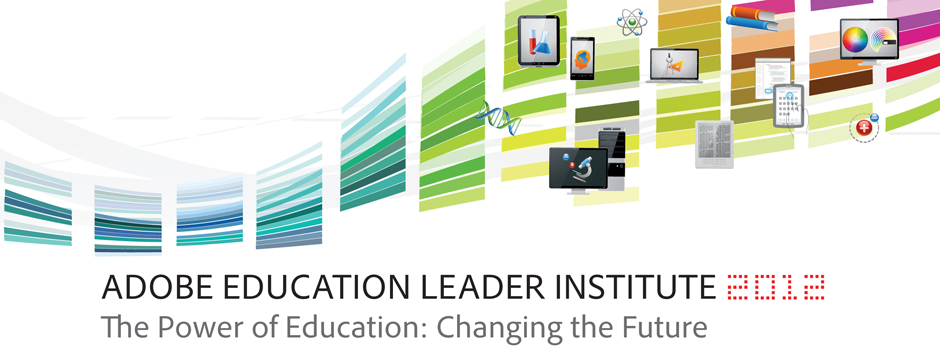Bright Ideas from Adobe
To most of us, Adobe are known as the company who develop Photoshop. Others know them as the company behind industry standard tools such as Illustrator and Acrobat. More recently they have been getting media attention with their proprietary format Flash, its lack of support on the iPad and Apple's reluctance to support this versatile developers tool. It appears that this has sent shock waves through the company.
Adobe have always had a strong presence in education. In 2011 their Creative Suite of software was shipped to 80% of Australian schools. And for good reason; The range of tools allowed for creative expression like never before. Used with the right direction from teaching staff and the software holds tremendous pedagogical value. Any student familiar with the design principles of Photoshop, InDesign or Illustrator have a head start with professions across the board.
My role as Technology Integration Specialist in education sees me liaising with hundred's of teachers, all of whom are determined to adopt 21st Century computing skills. Teachers understand that to achieve positive learning outcomes means not only engaging students with tools with which they are familiar, but also to challenge young minds, encourage hidden talents, and to communicate in different mediums. For many though, the thought of mastering any software which succeeds the word Adobe can put some teachers at unease.
The reason for this is simple. Adobe make software for professionals. They create extremely powerful ways that enable specialists to design brands. Adobe smash boundaries in web development, break down barriers for communication and make collaboration across the globe a snap. But to simply open an Adobe product and nurture the creative brilliance of our student’s minds can be tricky.
Fortunately help is at hand. Adobe seem to be investing considerable time and money to build the right networks and learning infrastructures to ensure that schools, colleges and universities are preparing our young adults for a modern workforce, one which will require higher order thinking skills, problem solving and authentic creative content. A workforce where the likelihood is Adobe tools are present, one where to "PDF" and "Photoshop" are Verbs.
On Tuesday 27th March I attended the Adobe Education Leadership conference in Sydney. I wanted to know how and why teachers should utilise Adobe tools. To say I left inspired is an understatement.
The transformation of learning.
Students, many adults and most early technology adopters are communicating and absorbing information in a very different way. Classrooms of the 20th Century were, for good reason very different to those of today. Teaching itself has, and is, undergoing a paradigm shift to accommodate the active minds of our modern students, and this was something which Jon Perera (Vice President, Adobe Education) reaffirmed in his opening talk.
This “paradigm shift†or changing model of teaching for 21st Century students, is something most teachers are aware of, although discovering and adopting new technologies to enable our students is a constant challenge. Jon Perera highlighted 3 main areas which Adobe are focusing on to provide a sound future in education:
- Multiscreen Technologies, (including cross platform compatibility) is the first key area. Empowering all students throughout the world, no matter from what socio-economic background, to benefit from digital media and to learn creatively is key.
- Capitalising on the Social Computing explosion, which we have experienced in the last 5 years, is also imperative. After all it is here where our students are most comfortable. It is here where students feel they have a platform and a voice to be heard. Enabling game and content creation and by integrating Facebook and Twitter gives purpose to many and empowers students... all while they are learning.
- Cloud Computing. This really encapsulates all of the above. When learning becomes always accessible, collaborative and around the clock, the need to store personal data securely is a must. Adobe Creative Cloud is a solution which not only provides syncing between devices, cloud storage and a social community, but also delivers seamless integration between all of Adobe’s main applications. It will be available this half of 2012 and shows much promise. http://www.adobe.com/products/creativecloud.html
Digital literacy and creativity.
To be able to grasp the concept of digital literacy is something that has often eluded me. The digital world is after all, constantly evolving. It progresses in order to enhance our lives and to be truly literate in this complex language is a struggle.
The digitally literate student should innovate through many different forms of media. They  should produce and manipulate beautiful images and insightful video. They need to collect and interpret information in manageable and meaningful ways. Across the curriculum students need to choose the right tools to demonstrate creative expression, both visually and aurally.
This creative expression is not reserved for the arts. In fact an initiative by the European Commission titled the European Year of Creativity and Innovation 2009 (EYCI 2009) surveyed 10,000 teachers. The findings showed that an "overwhelming majority" of teachers see creativity as being relevant in all subjects.
Why is creativity so important?
Teachers need to leverage creativity so that students are able to acquire concepts, internalise learning and externalise knowledge. This learning process works with our modern students and allows for a far greater reach across all students (including those with learning disabilities). Teachers already know this and Adobe realise this too.
By creating support networks such as the Adobe Education Exchange and Adobe TV, teachers and students are never far away from advice, tips and most importantly inspiration. A single Adobe ID gives you free access to all of their services so it’s simple and easy to benefit and I cannot recommend it enough.
The Adobe Education Exchange
This community of educators is amazing, if you are looking to utilise Adobe software in your lessons you must take a look at this http://edexchange.adobe.com. In just a few minutes you will discover fantastic, tried and tested projects which are all categorised into Age Group, Product (Photoshop, Illustrator etc), and Resource Type. Most of the projects directly support Australian Curriculum and with thousands of teachers downloading the resources, you have plenty of access to feed back and support if needed.
My favourite AEE project was titled Easy Circle Art. The lesson was listed by Judy Dirken and is listed as Grades 7-12. This project meets the ISTE (International Society for Technology in Education) NETS standards. The NETS (National Educational Technology Standards) set a standard of excellence and best practices in learning, teaching, and leading with technology in education.

Additionally if you or your students need some more technical direction, the Adobe TV website offers 100’s of training and instructional videos categorised by product. You will find many Adobe beginner guides and probably dozens of videos on how to cut out objects from the background!
The importance of training and development
Throughout the Adobe Education Leadership Forum an emphasis was placed on increasing teacher ICT confidence. This was re-enforced by Dr Sarah K. Howard from the University of Wollongong (NSW). Dr Howard demonstrated through a survey of 4,249 teachers adopting the Digital Education Revolution in NSW, that teachers are not reporting confidence with ICT in the classroom.
Lila Mularczyk is the principal at Merrylands High School. Merrylands have completed a successful roll out of Lenovo laptops to all staff and students years 9-12. Every laptop had the Adobe suite installed on it and the school focused on “Teacher Professional Learningâ€. This came in many forms, most impressive was the emphasis on building experts, who in turn became leaders and drivers. These staff ICT champions went on to assist other staff members. Students were involved in the PL too, with a student laptop team who provided assistance to staff students and parents. Innovation was encouraged and creativity quickly became the precedence at Merrylands.
Empowering students through creativity
The Digital Revolution has given Australian students the tools they need to voice themselves and learning becomes autonomous. Technology integration has proven to decrease truancy levels, increase critical and higher order thinking and in turn give students the best head start for their professional futures. Adobe software is at the forefront of all these things. They have acknowledged and addressed the need to adapt and simplify their software.
If you are considering implementing the Adobe suite across your campus I would highly recommend the Adobe Digital School Collection. This suite empowers students with diverse learning styles and abilities to showcase their knowledge across the whole curriculum. The suite includes Photoshop Elements, Premiere Elements, Contribute, Acrobat X Pro and Soundbooth. This means that your school or institute can start editing video, picture, audio, websites and share work easily between Mac and PC.
Adobe are also catering for tablet devices with Adobe Touch Apps. Currently there are 6 apps available across Android and iOS and it seems that Adobe are focusing heavily on these multiscreen mobile technologies. Adobe Photoshop Touch for iPad is an amazing example of how Photoshop can be simplified and scaled down for use with touch interaction. At just $9.99 I recommend you take a look.
Regarding Flash play back on the iPad, we were privy to a demonstration of Flash CS6. You may be pleased to hear that developers will be able to export their flash creations as HTML5. To the rest of us this means that we may start seeing more Adobe Flash content on the iPad!
The end of the day saw a beautiful demonstration from Sarah Kung, a 16 year old student from Sydney. Initially inspired by her brother, Sarah had discovered Photoshop and Illustrator on her laptop and set to work. Her first passion was typography but Sarah’s zeal for photo manipulation, vibrant colours, and creativity lead to discovering a hidden talent. I have included a couple of Sarah’s pictures in this article.

Both Microsoft and Apple offer a range of products which allow for multimedia creation. But no tools come close to the professional standards which Adobe have set. It is through these standards of design and workflows which have really set Adobe apart. Adobe have demonstrated resilience in the last few years and it is this ability to adapt and cater for modern professionals and students which has earned Adobe the confidence of millions of educators around the world.














